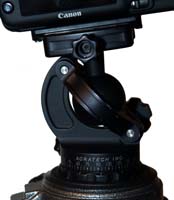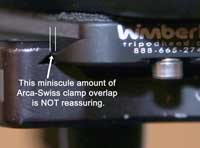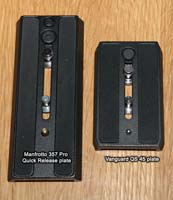 |
|
|
|

Vanguard SBH-300 Ball Head
(with comparisons to the Acratech
Ultimate)
|
Through 40+ years of photography
I seldom ever used a tripod, much preferring the freedom
of handheld shooting. After I switched to DSLRs, and finally
got my 500mm f/4, well, that changed everything. I very
quickly learned a tripod was an absolute necessity with
such a monster, and eventually added a Gitzo 1548 CF tripod
and Manfrotto 393 gimbal to tame the beast.
Something
else changed as well after the acquisition of that 500mm.
My subject matter ratio soon shifted from 50% birds/wildlife
and 50% nature/landscape/scenic to 95% birds/wildlife
and 5% nature/landscape/scenic. After that I slowly relented
to dragging along a tripod with my other lenses as well...albeit
a smaller tripod .... a Gitzo 1348 CF. My first ball head
for the 1348 was the Acratech Ultimate, which I bought
used. That tripod/ball head combo was more than sufficient
for my other lenses (17-40mm, 24-105mm, 70-200mm and 300mm).
The Acratech Ultimate has served me well, although as
you can see by the subject ratio of 5% to 95%, I really
don't use it very often.
 |
 |
 |
| The
Acratech's lightweight open diagonal design. |
The
Acratech's limited tilt opposite the "drop" side
or "notch" side, and excess tilt beyond 90°
the other way.
|
|
The
Acratech Ultimate had been the first (or certainly at
least one of the first) of the radical new breed of "cut-away"
ball head designs .... lighter, but odd-looking. I'd
never had the experience of using a standard "dome head"
design ball head, so I had nothing with which to compare
the Acratech. I just accepted it and used it, and was
never actually dissatisfied with its performance.
However,
a couple of things about the Acratech bugged me. One of
those issues was the lack
of tilt range in one direction, caused by the diagonal
design of the ball base. The other issue was too
much tilt in the opposite direction, when laying the
camera over for vertical shots. It stopped some 2-3 degrees
beyond vertical and had to be adjusted back to vertical
before locking the ball. This in turn made it more likely
I would bang the body against the tripod when the body
itself was attached to the clamp, as opposed to using
the lens foot as the mounting point. None of this was
a deal-breaker, and I used it as it was, though I quietly
wished I could do better.
 |
The
real issue and impetus for getting a different ball head
came about because the Acratech is the ONLY head I've
ever owned with an Acra-Swiss type clamp, which I never
liked from the first time used it. This has nothing to
do with Acratech at all, but strictly with the Arca-Swiss
style clamps on ANY product. I have pontificated on the
safety issues with Arca-Swiss clamps before, and would
never ever use one with any lens in the weight class of
a 500mm. I let this issue with the Arca-Swiss clamp slide
for awhile because I used it only with smaller lenses.
Finally though I decided this insecure, unsafe clamp had
to go. So I went looking for another ball head, in hopes
of solving all three issues with the Acratech.
I
checked out several brands recommended by members of my
favorite photography forum, one of whom touted the Vanguard
brand, among others he'd owned. Although made in China
(which to me automatically implied a high probability
of inferior materials and lack of quality) I could find
not one single bad review among the many good reviews
I read from several sources. Finding that it was available
from B&H Photo (which for me implied some modicum
of credibility) I checked it out.
 |
 |
Front
and back comparison views of the Acratech Ultimate
and Vanguard SBH-300 ball heads |
 |
 |
Above:
Comparison of the
Manfrotto 357 clamp on the
393 gimbal, and the QS-45
clamp on the Vanguard SBH-300.
Right: Both plates compared.
|
What
I discovered was that the Vanguard SBH-300 came with a
clamp and plate very reminicent of the Manfrotto
357 Pro Quick Release adapter which I so respected
for its safety features (the one I use with my 500mm and
393 gimbal). That was the clincher. I decided to give
it the benefit of the doubt and ordered the SBH-300 and
two additional plates. At just $99 for the ball head,
and only $15 for each additional plate (as opposed to
the ridiculous $50+ each for any Arca-Swiss style plate),
if it didn't work out I really wasn't out that much money.
Besides, B&H would probably stand behind it if I was
dissatisfied. It was a worthwhile gamble.
 |
 |
Base
comparison: The Vanguard
base diameter was a perfect
match to my Gitzo 1348 tripod.
|
The
Acratech issue of
over tilt beyond vertical was
improved with the Vanguard.
|
When
the ball head arrived, I found the finish and detail of
workmanship to be quite suitable. The instruction sheet
was absolutely minimal in scope, but I guess they had
to leave room for the other 13 languages it covered. The
English translation was not perfect, but better than most
I had seen.
 |
Tension
knob dial markings.
|
The
ball
head base has a 3/8 thread hole to mount onto the
tripod. It came with a 3/8 to 1/4 stud adapter insert
and a tool for removing or installing the insert. The
Vanguard base diameter is larger than the Acratech, and
turned out to be a perfect match for my Gitzo 1348 tripod.
The
Vanguard has both a tension
knob and a lock knob, a welcome change from the single
knob of the Acratech. I find it easy to get just the right
tension setting, even with a 7D and 300mm f/4 mounted.
The tension knob does not have Arabic numeral markings,
but instead has
dots like those on dominoes. This seems a very Chinese-centric
solution, but if you think about it you will realize it
works in any language. I expect though they will be harder
to read in poor lighting than larger single digit numbers
would be.
 |
| Ball
head with plate inserted showing the 2 bubble levels
and red safety catch release button. |
The
panning lock knob holds firmly, yet does not offer to
bind when I go to loosen it. The ball motion under tension
feels so smooth I almost believe I could follow BIF shots
with the ball head as if it were a gimbal, though I doubt
I'd ever actually try BIFs with any ball head (and certainly
not with a lens that could be otherwise handheld). The
tension knob will tension the ball, and the lock knob
will lock it, but not in the manner expected. I eventually
found issues with the tension and lock knobs, so read
my "Issues?" paragraph at the bottom of the
page for an explanation, and decide for yourself what
you think.

|
Two
bubble levels molded on the
outside edge of the clamp are
easily visible.
|
Two
bubble
levels are intelligently located at the outer edge
of the clamp base where they can be easily seen (not hidden
under the clamp plate as in at least one high-priced Arca-Swiss
style clamp I came across in my research of ball heads).
The clamp features a spring loaded safety catch pin that
engages when the plate slides into the clamp. It does
not have the distinctive and reassuring loud click when
it engages as does the Manfrotto 357 clamp I'm so used
to, but it engages nonetheless. You must slide the plate
in because the clamp jaw does NOT spread. Once the plate
slides into the clamp, it cannot fall out, even if you
forget to screw down the clamp knob. You must press the
red
button to release the safety catch in order to slide
the plate out. These safety features were exactly what
finally convinced me to try this ball head. The clamp
knob requires only about a 3/4 turn to tighten fully.
The
Vanguard clamp
knob easily clears the base panning scale ring and
tripod when flipped into the vertical slot as shown at
right. This provides an improved vertical angle over the
2-3 degrees past vertical tilt error of the Acratech,
but the Vanguard is still off by about 1/2 degree past
vertical. That's pretty close but not perfect.

|
The
slot for vertical shots is
improved over the Acratech, but
still off by about 1/2 degree.
|
One
clamp plate was already included with the ball head. Since
I ordered two additional plates, I have plenty to go around.
In fact, at just $15 each, it's quite ecomomical to have
one for every lens or body you might use with this ball
head. Another nice feature is that the corners
of the QS-45 plate are beveled, which guides it into
the clamp more easily than the Manfrotto plate, which
is not beveled. Each plate includes both a 3/8 and 1/4
screw. The QS-45 clamp base has two
threaded indentions where you can store one of each
size screw when not in use, which is another intelligent
feature similar to the Manfrotto 357 clamp.

|
"Flying
Saucer Ball Head"
with Manfrotto 357 clamp.
|
One
review I read of this ball head noted the QS-45 plates
will fit the Manfrotto 357 clamp but not vice-versa. I
can confirm that. The larger, longer 357 plate won't fit
the ball head clamp since the plate is about 1/8 inch
too wide. The only issue with the QS-45 plate in the Manfrotto
357 clamp is that the safety catches on the two clamps
operate a little differently. When you slide the smaller
plate into the 357 clamp, the safety catch will engage
and hold it from coming out. However, you will discover
the catch will not disengage when you press the release
button. After a little fiddling with this problem I found
that simply lifting the plate a little while the clamp
is loosened allows it to slide out over the catch pin.
Now I know that in a pinch, I can use a lens with the
QS-45 plate in my Manfrotto 393 gimbal. Since I also have
a 357 clamp on the "Flying Saucer Ball Head" I created
for bean bag use, I can now slip other lenses onto it
just as I do the 500mm with the large plate. That's going
to be a handy side benefit.

|
Vanguard
SBH-300 ball head with
7D and 300mm f/4 L mounted.
|
Round-up
of specs and features:
| Weight
- 1.66 lb. |
Tension/ball friction knob
|
Lightweight
Magnesium Alloy |
| Capacity
- 70 lb. |
Ball lock knob
|
Includes
quick clamp and plate with safety catch |
| 2
bubble levels |
Pan lock knob
|
Tilt
range - 40 degrees plus one 90 degree slot |
As to the weight capacity
rating of this Vanguard, or of any ball head for that
matter, I would take any of them with a grain of salt.
For example, who has a 70 lb. lens in the first place,
and would your tripod even take that? Lets stick to common
sense and reason here. I would not use any lens on this
ball head larger than a 400mm f/5.6, 100-400mm f/4.5-5.6
or 400mm DO. The same thing goes for ANY ball head, no
matter how many tons it's "rated" to handle.
Why? Well, my take on the matter is... if it's large enough
for a gimbal head, then it should be on a gimbal head
and not a ball head. Safety first! I think a combination
of body and lens weighing up to 6 or 7 pounds will do
well on this ball head. Above that range, I think the
handling and stability would become somewhat tenuous.
Issues?
Are
there any negatives to this ball head? That 1/2 degree
error in the vertical slot was the first negative, but
I'm not sure it's any worse than the expensive ones. After
considerable time in the field with this ball head I realized
there is some unexplained interaction between the "tension"
knob and the "lock" knob. You can set a tension, then
lock it down with the lock knob, but if you then alter
the tension, it is no longer locked, and the lock knob
will turn further than before to reach a lock mode. That
in turn alters the tension setting for the same tension
feel. So, it appears that neither is actually a tension
knob. They both act essentially as lock knobs and do not
actually allow any preset tensioning. That's not how I
expect a ball head to work, and a big reason I would NEVER
use a heavy lens on any ball head. What good
is it if you just locked it, only to find it isn't, or
the tension you just set no longer provides any tension?
In my book it's worse than useless, it's dangerous. The
only half way safe thing you can do with it is flop it
over into the slot and use it like a gimbal.
In
the final analysis I can only recommend this ball head
for basic use on lightweight gear, with the knowledge
and understanding of how the tension and lock knobs "sort
of work". For a $100 class ball head it does the
job, but with caveats. As long as you understand what
you're getting, it might work for you. |
| |
|
|
 |
|
 |
